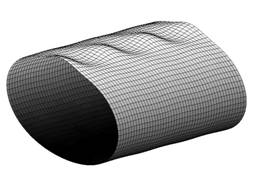Structural Stability of Elastic Cylindrical Shells under Pressurized Bending
by Sotiria Houliara
Graduate Diploma Thesis, March 2005
ABSTRACT
The current study presents the work conducted on the stability of elastic cylindrical shells. The stability of elastic shells under bending is a challenging topic in structural mechanics and has been previously treated by several researchers. An extended literature review is presented for a better understanding of elastic bending behavior. The tube response is considered as a combination of ovalization instability (Brazier effect) and bifurcation instability (buckling), and it is investigated numerically and analytically. A non-linear numerical technique, briefly described in chapter 2, is employed, using a continuum-based numerical finite element formulation.
In chapters 3 and 4 instabilities of long thin elastic cylinders are examined. This study concentrates on the case of initially straight cylinders under in-plane bending considering the effects of pressure. The two instability modes (ovalization and buckling) are distinguished and examined in detail. Numerical results based on the nonlinear finite element formulation are presented. Furthermore, a simplified analytical approach is employed and closed-form expressions are obtained for the moment that causes ovalization and bifurcation instability, the corresponding curvatures as well as the buckling wavelengths. This simplified analytical formulation is based on the local character of buckling in the circumferential direction. The efficiency and accuracy of these analytical relations is examined through the comparison with numerical results. It is shown that the predictions of the closed-form expressions are closer to the numerical results for thin-walled cylinders. Furthermore, initial post-buckling response is discussed, using a simple mechanical model, proposed elsewhere, as well as observations from numerical results. It is demonstrated that the bifurcation point is non-symmetric with respect to the lateral deformation of the tube wall.

In the last part of this study issues of nanotubes related to buckling of cylinders are discussed. This has received significant attention in the recent years. More specifically, the implementation of shell stability concepts to simulate buckling and post-buckling response of carbon nanotubes is an open research issue. The present work is mainly focused on the investigation of the applicability of continuum shell theories to the mechanics of carbon single-walled nanotubes under bending loads. Particular emphasis is given to issues regarding the ranges and limitations of continuum modeling.